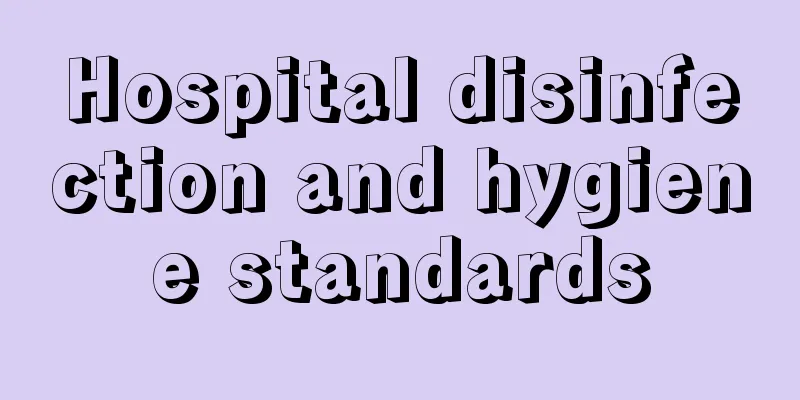Hospital disinfection and hygiene standards

|
We all know that hospitals are places full of patients. Correspondingly, there are also a lot of bacteria in hospitals. This is why many friends are reluctant to go to hospitals for fear of contracting diseases. In fact, as a place to treat diseases, hospitals must have protective measures, such as disinfection. So, what are the hospital disinfection and hygiene standards? Let us all learn about this knowledge together. In fact, the disinfection and hygiene standards of hospitals are very high. If there are no strict standards, the hospital will become a source of infection, which is not allowed. The hospital's disinfection system standards are as follows, which we can learn from. Hospital environment cleaning and disinfection system 1. The rags used in the treatment room, dressing room, office, etc. should be used separately and must not be mixed. After use, soak it in 500mg/L chlorine-containing disinfectant for 30 minutes, then rinse it with clean water and dry it for later use. When in use, wipe and disinfect with 500mg/L effective chlorine disinfectant. 2. Bed rag (small towel): Use one bed and one towel for wet cleaning. After use, soak and disinfect in 500mg/L effective chlorine disinfectant for 30 minutes, wash clean, dry and set aside. 3. Mops: They should be clearly marked and used in strict accordance with the following areas: ⑴ Mops in general wards, offices, treatment rooms, and dressing room corridors should be rinsed with clean water after each use and hung to dry for later use. ⑵ When there is blood, secretions or excrement on the floor of wards, treatment rooms, dressing rooms, etc., first pour an appropriate amount of 1000mg/L effective chlorine disinfectant on the contaminated floor for 30 minutes, then mop it clean. Soak the mop in 500mg/L effective chlorine disinfectant for 30 minutes, then wash it clean, dry it and set it aside. ⑶ Infectious disease areas should be disinfected after use. Soak them in 1000mg/L effective chlorine disinfectant for 30 minutes, then rinse them with clean water, and then soak them in 500mg/L effective chlorine disinfectant for 30 minutes, and hang them to dry for later use. 4. Disinfection of the ground: ⑴ When there is no obvious contamination on the ground, wet cleaning is usually adopted, and the floor is mopped with clean water or detergent 1-2 times a day. ⑵ When the ground is contaminated by pathogenic bacteria, use 500mg/L of effective chlorine for disinfection for 30 minutes. If it is contaminated by pathogenic spores, mop or spray the ground with 1000mg/L disinfectant. 5. The tables, chairs, stools, bedside tables, etc. in the ward generally only require daily cleaning and sanitation, and should be wiped twice a day with a clean wet cloth. When contaminated by pathogens, wipe or spray the surfaces of various objects in the room with 500 mg/L of effective chlorine for disinfection. After reading the above introduction to hospital disinfection and hygiene standards, I believe everyone should now have some understanding of the hospital disinfection standards. In life, those of us who are afraid of being infected by hospital viruses may wish to read the above introduction. In this way, I believe everyone should no longer be timid about hospitals. |
Recommend
What are the effects and functions of turmeric powder?
The effects and functions of turmeric powder incl...
What to do if you don't have confidence in yourself
Because of different growing environments and exp...
How do breast cancer patients choose endocrine therapy
For breast cancer patients, endocrine therapy is ...
I felt restless and irritable until midnight
Sleep is very important for a person, because onl...
How long can you live with melanoma? Can it be cured?
For most melanoma patients and their families, ho...
How to treat costochondritis 5 effective treatments
Costochondritis is a chronic inflammation that oc...
How to treat deficiency that cannot be supplemented
Everyone knows that if the body is very weak, it ...
Is it useful to stay up late and make up for sleep during the day?
Nowadays, many young people often stay up late. S...
What does a man think about after he ejaculates?
During sexual intercourse, women may not always b...
Which is the best hospital for treating bone cancer at present?
Bone and joint pain, bone lumps and movement diso...
What to do if you have tooth decay pain?
It is said that toothache is not a disease, but i...
Scalp wound suppuration
Scalp wound suppuration is quite common in our da...
How to clean oil stains on clothes
When you see oil stains on your clothes, you will...
Will eating apples cause internal heat?
Apple is a very common fruit in our lives. Many p...
What is the water temperature for taking a bath when you have a fever
Fever is a very common symptom, and the causes ar...









